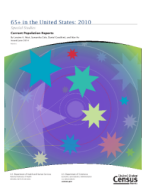65+ in the United States: 2010
65+ in the United States: 2010
Preface
In 2011, the Baby Boom generation, people born from 1946 to 1964, began to turn age 65. As the large Baby Boom cohort ages, the United States will experience rapid growth in both the number aged 65 and older and their share of the total population. The social and economic implications of the aging of the U.S. population will be of significant interest to policy makers, the private sector, and individuals.
This report examines a range of topics concerning the population aged 65 and older in five chapters. Chapter 1—Growth of the Older Population—discusses the age structure of the older population and its distribution by race and Hispanic origin. Chapter 2—Longevity and Health—addresses mortality, health behaviors and risks, chronic conditions and disability, long-term care, and health insurance. Chapter 3—Economic Characteristics—covers work and retirement, income and poverty, and the impact of the 2007–2009 recession on the older population. Chapter 4—Geographic Distribution—describes the geographic distribution of the older population across regions and states by race and Hispanic origin along with older people’s migration patterns. Chapter 5—Social and Other Characteristics—looks at a range of sociodemographic characteristics of the older population, including marital status, education, living arrangements, and veterans status.
The topics highlighted in the report update trends documented in previous versions of this report. The first edition was written by Cynthia M. Taeuber with Bonnie L. Damon and published in 1993. The second, titled 65+ in the United States, was prepared by Frank B. Hobbs with Bonnie L. Damon and published in 1996, and the third was 65+ in the United States: 2005, written by Wan He, Manisha Sengupta, Victoria A. Velkoff, and Kimberly A. DeBarros and published in 2005. All three earlier editions as well as the current one were commissioned by the National Institute on Aging, Division of Behavioral and Social Research, Richard M. Suzman, Director.
Compared to previous reports, this report expands on the discussion of long-term care and nursing homes and includes an assessment of the impact of the December 2007 to June 2009 recession on older Americans.
Data used in this report draw heavily from the 2010 Census; nationally representative surveys such as the Current Population Survey, the American Community Survey, and National Health Interview Survey; the national vital statistics system; and recent population projections for the United States and other countries. This report also incorporates survey data and analytical findings from numerous studies about the older population prepared by the Census Bureau, other federal agencies, and private researchers, including research funded by the National Institute on Aging, Division of Behavioral and Social Research. For a more detailed discussion of data sources, see Appendix A: Sources of Data.
Statistics from surveys are subject to sampling and nonsampling error. All comparisons of characteristics based on U.S. sample data have taken sampling error into account and are significant at the 90 percent confidence interval. For a more detailed discussion of data accuracy, see Appendix B: Accuracy of the Estimates.




